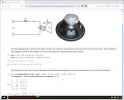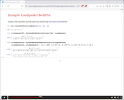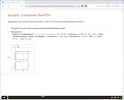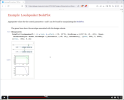- Joined
- May 1, 2021
- Messages
- 469
- Likes
- 1,424
First, those cork screws:

The one of the left shows the phasor, meaning the complex value at t=0, with its development in time e^(iwt) appended. This is not a wave travelling through space, this is simply adding on a trivial term that is anyway divided out in a transfer function, as it is found in both the input and the output. That is why a signal, when assuming sinusoidal steady-state behavior, can be written as complex number with magnitude and phase only.
The one on the right has a frequency axis, not a time axis, and again, this is not hurtling through space. This shows exactly the phasor part, at each frequency, without the above-mentioned time dependency. This is just a more difficult-to-read version of magnitude and phase, and holds no more or less information than that.
Second, I am not saying that the physics is not contained in the transfer function, i.e. real and imaginary parts, or magnitude and phase. It certainly is. When you measure a loudspeaker, and relate your findings back to input voltage, then that voltage is the reference, and so measured phase is relative to that. That phase (and magnitude) is a consequence of the electromechanical setup of the transducer and the coupling between the structural mechanics and the acoustics. If there is wave propagation involved, as there would be here, it may or may not be contained in the phase, as the user will have to click, or not, on a setting regarding how far away the loudspeaker is.
However, a wave is a global abstraction, whereas the measurement signals are in points. There is no immediate need for thinking about waves, when learning signal processing. That is why most introductary chapters are called Signals and Systems, with no mention of physics. If you only try to learn via physics/measurements, you will never understand why compled numbers, negative frequencies, and complex conjuation, have to be introduced as soon as you talk signal processing.
If you don't understand the fundamentals of signal processsing, you are probably lacking in other places too, and I see many projects being cancelled, just because the engineers could not succeed with understanding why the test keeps failing, and if only the basics were in place, you would be able to quickly pinpoint at which point things start to break down regarding for example certain assumptions you have made, that do not actually hold, or whatever the case may be. There is only the hard way of studying way beyond your formal education to get deep into all of these aspects.
Things can go really wrong if you for example think that a driver will always produce postive pressure for positive displacement. I saw a phd level employee think this at a former workplace, which was leading to a remedy for feedback stability that would have made everything worse, not better. This situations come up all the time, but if nobody is there with proper knowledge, it will be written of as "oh, we know simulations and measurements never match", which is of course nonsense.
The one of the left shows the phasor, meaning the complex value at t=0, with its development in time e^(iwt) appended. This is not a wave travelling through space, this is simply adding on a trivial term that is anyway divided out in a transfer function, as it is found in both the input and the output. That is why a signal, when assuming sinusoidal steady-state behavior, can be written as complex number with magnitude and phase only.
The one on the right has a frequency axis, not a time axis, and again, this is not hurtling through space. This shows exactly the phasor part, at each frequency, without the above-mentioned time dependency. This is just a more difficult-to-read version of magnitude and phase, and holds no more or less information than that.
Second, I am not saying that the physics is not contained in the transfer function, i.e. real and imaginary parts, or magnitude and phase. It certainly is. When you measure a loudspeaker, and relate your findings back to input voltage, then that voltage is the reference, and so measured phase is relative to that. That phase (and magnitude) is a consequence of the electromechanical setup of the transducer and the coupling between the structural mechanics and the acoustics. If there is wave propagation involved, as there would be here, it may or may not be contained in the phase, as the user will have to click, or not, on a setting regarding how far away the loudspeaker is.
However, a wave is a global abstraction, whereas the measurement signals are in points. There is no immediate need for thinking about waves, when learning signal processing. That is why most introductary chapters are called Signals and Systems, with no mention of physics. If you only try to learn via physics/measurements, you will never understand why compled numbers, negative frequencies, and complex conjuation, have to be introduced as soon as you talk signal processing.
If you don't understand the fundamentals of signal processsing, you are probably lacking in other places too, and I see many projects being cancelled, just because the engineers could not succeed with understanding why the test keeps failing, and if only the basics were in place, you would be able to quickly pinpoint at which point things start to break down regarding for example certain assumptions you have made, that do not actually hold, or whatever the case may be. There is only the hard way of studying way beyond your formal education to get deep into all of these aspects.
Things can go really wrong if you for example think that a driver will always produce postive pressure for positive displacement. I saw a phd level employee think this at a former workplace, which was leading to a remedy for feedback stability that would have made everything worse, not better. This situations come up all the time, but if nobody is there with proper knowledge, it will be written of as "oh, we know simulations and measurements never match", which is of course nonsense.




